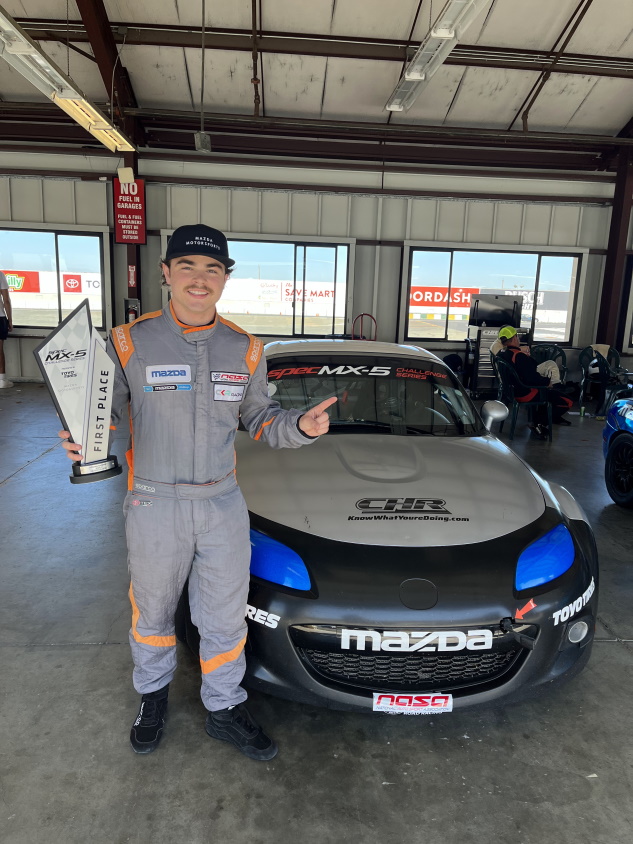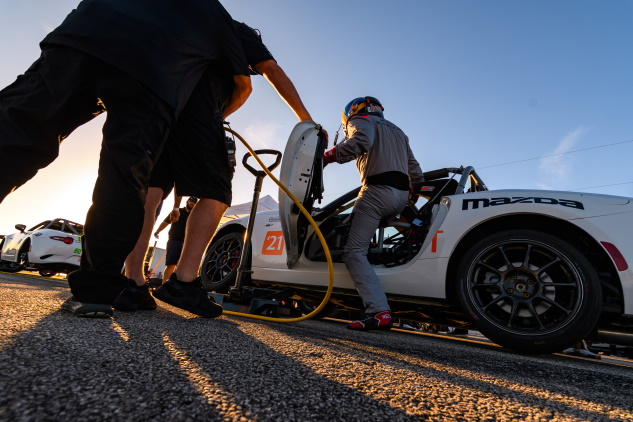Features
Brother Clayton Ketcher (Columbia) races to compete while balancing college and time with his chapter.
 The camera pans across Watkins Glen International, affectionately known as “The Glen,” on a sunny summer afternoon. The pack of Mazda MX-5s move in a two-wide formation down the road course that has hosted Formula 1, NASCAR, and IndyCar races for decades. It’s considered to be the Mecca of North American road racing with segment nicknames like The Boot, Heel, and Chute.
The camera pans across Watkins Glen International, affectionately known as “The Glen,” on a sunny summer afternoon. The pack of Mazda MX-5s move in a two-wide formation down the road course that has hosted Formula 1, NASCAR, and IndyCar races for decades. It’s considered to be the Mecca of North American road racing with segment nicknames like The Boot, Heel, and Chute.
On this sunny day in June of 2023, Clayton Ketcher (Columbia) is strapped into his Number 19 car, white livery with a green racing stripe. The video footage is deceiving, as it almost always is for motorsports. The only sign that these relatively lightweight machines, almost 1,000 pounds lighter than a NASCAR car, are moving at over 100 mph is the high-pitched screeching from their engines, a trait that led spectators to refer to them as a pack of angry bees.
The cars begin to finish their formation lap and head toward the green flag, marking the start of the race. They tighten up. The clock is set for 45 minutes. You’d be lucky to squeeze a textbook between the bumpers of the leading four cars.
“Are you ready to be entertained,” says the broadcaster.
Into the first corner, several cars go three-wide.
“Oooh there’s a spin!”
And then chaos.
Hailing from Sacramento, Calif., Ketcher grew up loving cars. Unlike the racing dynasty families that seem to dominate motorsports, Ketcher’s family had no experience with it.
“I did my own research and kept seeing that all of these drivers got started with karting. I basically bugged my parents until they finally let me give it a try.”
If professional racing is the major league, karting is little league. Almost all of today’s major professional drivers across every racing series started as kids in kart racing. Imagine the go-karts you see at tourist destinations and dial that up to 11. That’s karting.
“I started in the 7th grade and immediately met so many new people,” says Ketcher. “You also learn a lot and begin to get comfortable with racing.”
From karting, Ketcher began to move up into actual cars. In 2022, his last year before moving to a professional series of racing, he racked up several impressive performances, which earned him a good amount of prize money to carry into 2023, a critical need since Ketcher’s parents have been his biggest supporters and funded much of his racing. Even then, the prize money from Mazda would only cover about half of his anticipated 2023 racing costs.
“Right now, I’m at what people would consider Single-A level in baseball terms. Above this are different professional series and would require some sponsorship help to get to that next level.”
The level he’s referring to is Spec Miata Racing. Every driver, in theory, drives an identical Mazda MX-5. Regulations provide boundaries of what can be done to the car, but there’s still some room to modify slightly.
 While a NASCAR race winner is determined by who’s in first after a set number of laps, Spec Miata is a time trial. Every race has a 45-minute clock, and drivers attempt to log the fastest time in that window. And the difference between first and second can often come down to tenths of a second. On the first race of the same Watkins Glen weekend, Ketcher came in 14th place overall and 3rd place among the rookies on track with a time of 45:47.535. The driver who placed just above him logged a time of 45:45.027.
While a NASCAR race winner is determined by who’s in first after a set number of laps, Spec Miata is a time trial. Every race has a 45-minute clock, and drivers attempt to log the fastest time in that window. And the difference between first and second can often come down to tenths of a second. On the first race of the same Watkins Glen weekend, Ketcher came in 14th place overall and 3rd place among the rookies on track with a time of 45:47.535. The driver who placed just above him logged a time of 45:45.027.
Since the cars are all relatively the same, that small gap usually rests in the hands of the driver. Although some may argue that motorsports aren’t “real” sports, it’s hard to argue over the amount of physical and mental training it takes to be successful.
“Physical training involves going on runs and lots of strength training,” Ketcher explains. “I want to ensure I have that endurance skill built up because you have to be ‘on’ for an entire race.”
Sim racing is also a significant training activity, helping with track memorization and muscle memory. In a game of seconds, it’s critical to know exactly how much brake to give or how much into a turn you want to go.
And, of course, there is what Ketcher calls “seat time” training, which is actually driving a car on a track as if you were in an actual race. In that environment, a driver has to begin listening to the machine as much as himself and learn exactly how far he can push the envelope and what limits the car has. You’d think that would be mostly with the hands on a steering wheel, but Ketcher explains that the other end of your body is what becomes important.
 “Waist down is really where you feel the car,” Ketcher says. “A lot of your feedback from the car is coming from your pants in the seat and your feet on the pedals. It sounds cliché, but you really do become a part of the car and have to rely on what you’re feeling. It’s a weird sense to tune into and takes a lot of practice to master.”
“Waist down is really where you feel the car,” Ketcher says. “A lot of your feedback from the car is coming from your pants in the seat and your feet on the pedals. It sounds cliché, but you really do become a part of the car and have to rely on what you’re feeling. It’s a weird sense to tune into and takes a lot of practice to master.”
All of this would seem like a lot for any 21-year-old, but it becomes even more impressive when you consider that Ketcher is also a full-time student double majoring in German and Economics.
When he moved across the country to New York City for college, it was his father’s fraternity experience that inspired him to consider joining a fraternity.
“While it wasn’t an expectation that I join a fraternity, I had grown up hearing about the friendships he made and the experiences he had. I wanted that too, and during recruitment, the Sigma Nu guys were who I clicked with the most and felt comfortable being around.”
And how do the Delta Gamma Chapter (Columbia) brothers react to Ketcher’s racing career? Nothing short of positive.
“The chapter brothers are stoked about it and super supportive. It’s a pretty rare sport to be involved in so they always want to learn more. It’s been really heartwarming to see my brothers take such a keen interest in what I’m doing, but also in me as a person and the passion I have for it.”
It’s pretty common that Ketcher will get texts from brothers going into a race weekend or comments on his Instagram.
Sigma Nu also helps provide a brotherhood for Ketcher outside of racing.
“Sometimes sports can be an echo chamber, so it’s nice to have guys I can just be me around and not be a driver. We all have unique interests and hobbies, and we’re all interested in what each other are doing.”
Of course, his biggest supporters are his family: Keith, his dad, Gina, his mom, and Sam, his younger brother,
“My dad’s fully supportive, even if he’s writing a lot of the checks,” he says with a laugh. “And my mom has fully become a race mom. She always tells me, ‘When I signed you up for karting, I had no idea this is what it’d turn into.”
When asked what mom thinks about the danger involved, Ketcher reveals she has her own coping technique. “She’s a photographer, so she takes pictures during the races to help keep her mind off of it.”
Back at Watkins Glen, in only the blink of an eye, the 82 car begins to fishtail before doing a sharp 90-degree turn, careens across the track, and does a T-bone right into the side of the 19 car. Ketcher’s car.
“It’s a weird experience,” Ketcher reflects on the crash. “I never saw the other car coming at me. I just hear this crunch as we collide, let out a grunt, and honestly just closed my eyes.”
The 19 does a complete 180, his front left tire ripping off and rolling down the track. Ketcher’s car almost turns completely on its side but instead drags across the asphalt and bounces into the grass before settling.
“While crashes are always going to be a part of racing, no one expects it to happen to them.”
But this time, it did, and it was even more unfortunate because this was the 2nd race of only two that Ketcher had planned to race all season.
“Oddly enough, I’m not even thinking about my race right after. I’m thinking about everyone else and making sure everyone’s okay.
Everyone wants to have fun. If you’re not having fun, you wouldn’t be there. There’s this common bond…a shared loved of driving, and everyone’s looking to make this sport better. It’s a strange sense of camaraderie.”
Kind of like a fraternity.
